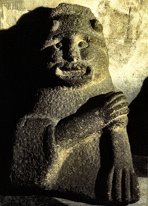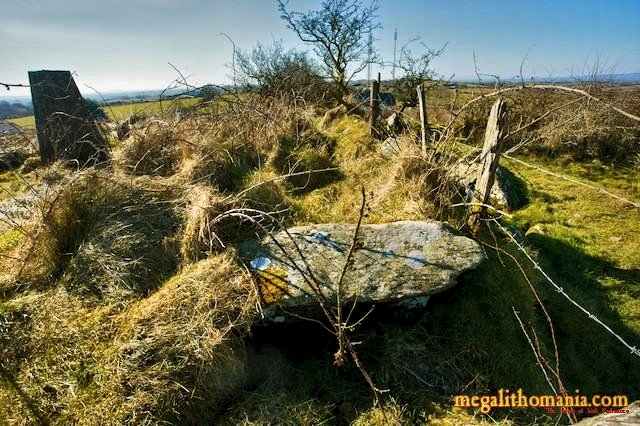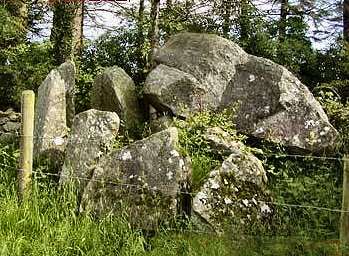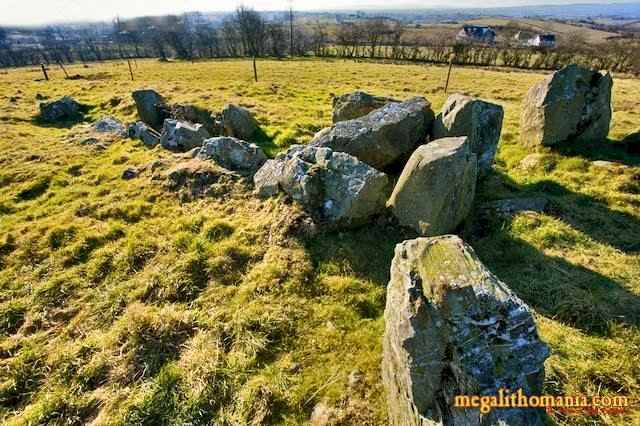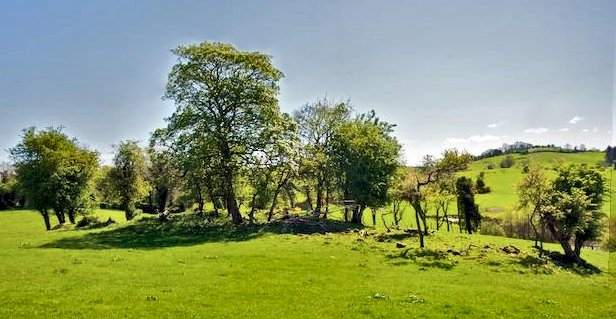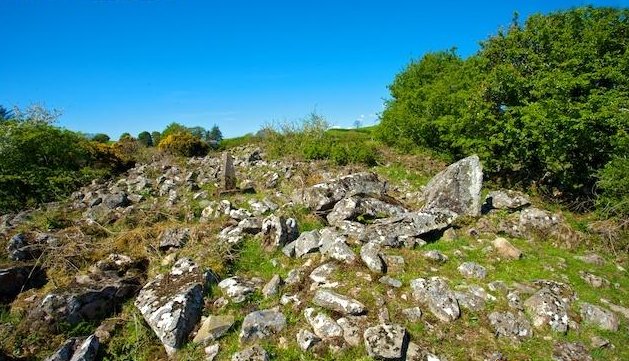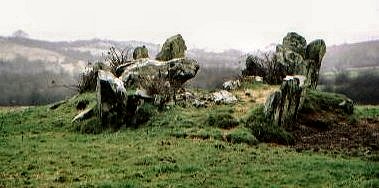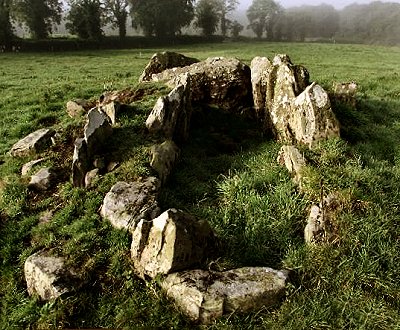county list
|
Turn smartphone to horizontal
view. SELECTED SITES IN COUNTY MONAGHAN Place-names in italics refer to listed entries. Convert Irish Grid references to Latitude/Longitude |
|
About 8 km SSW of Monaghan town, in a fine situation on top of a drumlin (hillock) about 250 metres NE of a transmitter, beside an old laneway leading N from a by-road from which the tomb is visible, this tussocky tomb is ruined but interesting. It is built of large stones, and has a gallery 7.5 metres long, with remains of double walling, especially on the S side. At the front there is an ante-chamber that is separated from the gallery by a septal slab. Inside there is a displaced stone leaning against one of the walls. It is too small to have been a roofstone, so it could have been an orthostat originally placed to make a split portico. A few roofstones remain. To the front and side of the mound, which is nearly 20 metres long and over 10 wide, there are two large upright stones (2 metres high) which could be original features or re-erected roofstones. Upright stones at the fence at the rear edge of the tomb could be part of the original kerb. Do not mistake the triangulation-marker for an original stone!
~ 2.5 km WSW in Carn is a court-tomb (see under Garran, below). ~ 4 km WSW is Garran portal-tomb. Drumirril - see under Ballinloughan, county Louth. Edergole:
Court-tomb Just over 3 km NNE of Rockcorry, 400 metres W of Edergole school, by the N side of a by-road which has cut through the tomb, part of it is incorporated in the road-fence. Part of the gallery, however, composed of very large boulders, survives - plus one roofstone 2.1 metres square, raised on jambs to a height of 1.5 metres. The SW end of the gallery, and the court, have been swallowed up by the road. It is very surprising that anything of the tomb at all remains, because many such tombs (perhaps dozens or scores) were demolished to provide road material and stones for other edifices.
Garran: Portal-tomb About 50 metres W of the Monaghan-Newbliss road, incorporated into a field-wall behind a two-storey house some 8 km NE of Newbliss, this is one of the best monuments in Monaghan. Steps lead up the wall and then down between the portal stones to the chamber of this tomb (1.8 metres by 90 cms) which remains intact despite the slipping of the large capstone, 2.4 metres long and one metre thick. It is composed of eight stones, including two portal-stones 1.5 metres high (the right-hand one split in two) and a low back-stone - but no door-stone.
~ 1.5 km E by N and about 50 metres N of a lane in Carn (H 611 258) is a court-tomb with a wedge-shaped cairn 35 metres long. The façade of the U-shaped court is well-preserved, with large orthostats flanking the portal-stones. The lintel over the entrance lies in the first chamber of the three-chamber gallery A couple of façade stones can be seen at the front edge of the cairn, which is now only about 40 cm high.
~ 3.7 km N of Garran at Killina (H 598 294) is a complete and cairn-covered court-tomb, 50 metres long, which has trees growing out of it and overlooks a small lake. Some stones protrude from cairn material, including an arc at the W end which is probably a court.
~ About 3.2 km N by E of Garran portal-tomb, in a field at the end of a farm lane running W from the main road in Tiredegan (H 602 286) is a double-court tomb, much of whose cairn (30 metres long) survives to a height of over one metre. Some of the stones of the E court still stand, and a large lintel still rests on the portal-stones. Only one large chamber (1.8 metres wide and 5 metres long) is traceable: details of the W end of the tomb are obscured by cairn material. Some of the kerb on the S side projects above cairn-spill.
~ 4 km NNE of Garran, and 7.5 km SW of Monaghan town in Carnbane (H 613 291) is a large, almost-intact, but tree-obscured court tomb. The court is is detectable, but is full of cairn material. The cairn itself survives to a height of 1.6 metres. The tops of several court-stones stick above it, and there are two exposed façade stones at the front edge, one of which is over 2 metres tall. ~ 6.5 km NNW of Garran portal-tomb in Clogherna (pronounced 'Clarna', H 580 287) is another double-court tomb, rather ruined, but retaining one of its galleries, over 5 metres long and composed of large orthostats including a backstone 1.2 metres high. Lennan:
Portal-tomb Picturesquely visible up a slope from a by-road, the fine, pitted capstone of this tomb has slid back, taking the portals with it, so that it is now just a little cave acting as a field-dump. The portals have very beautiful quartzite banding in their stone. ~ 2.2 km SSW in Dunmaurice, just behind a house (H 741 214) and surrounded by the usual plastic sacks, rusting metal, old drums, wire, tractors etc., are the sad remains of a court-tomb: just a pair of jambs and a fine lintel in a rural slum.
~ 5.5 km NE in a tiny copse in Croaghan (H 797 256) are the interesting remains of a complex structure containing seven separate two-chambered galleries which are only roughly parallel, through which a short track has at some (possibly prehistoric) time been driven, because it is lined with fine megalithic orthostats or roof-stones. Only excavation could determine the chronology of these tombs, but it seems like one court-tomb became, possibly over a period of hundreds of years, a complex monument. Stone for at least some of the galleries came from an outcrop nearby which the visitor will pass. The name of the townland in Irish must refer to this interesting and anomalous monument.
~ 5 km N of Croaghan is the fine standing-stone at Mullyard in county Armagh. Lisnadarragh:
Wedge-tomb Close to a minor road, almost in county Cavan, 2 km N of Shercock, this roofless but impressive ruin looks like giant false teeth. There is a marked decrease in the size of the orthostats from front to back (SW to NE), and a single roofstone lies to the SE of the relatively narrow gallery. ~ 2.5 km WNW in Corgreagh, also near the road (H 699 082), is Labbyfirmore or 'The Big Man's Bed', a ruined court-tomb hidden in trees and bushes. All that can be seen are the N (front) end of the gallery: a large displaced roofstone resting on a sidestone, and three stones at right angles nearby which are the remains of a subsidiary chamber opening to the W. ~ 7.5 km SW (6.5 km WSW of Shercock and 6 km NNW of Bailieborough, in county Cavan) is another wedge-tomb at Drumeague (H 667 028), also roofless apart from a large displaced roof-stone. It has a fine door-slab still in situ, the rear buttresses, and much of its double-walling.
~ Many kilometres to the E, on sheet 36 and only just in county Monaghan are the petroglyphic stones of Drumirril and Comraghs: see under Ballinloughan, county Louth. Mullyash:
Passage-tomb Easily
accessible by a signposted forest track (some 7.5 kim NE of
Castlebayney) but regrettably surrounded by dreary exotic conifers,
this hilltop tomb commanded magnificent vistas before forestation:
to Slieve Gullion, Loughcrew, the Mourne and Carlingford
Mountains. A stepped, two-tiered cairn with some of its original
facing intact, and closely resembling that of Newgrange before
it was tarted up, almost certainly contains a passage-tomb.
The
site was until circa 1950 a site for Lughnasa celebrations.
A standing-stone, probably once connected with the celebrations
lies broken (by Christians in a long, but erratic, tradition
of smashing 'idols'?) some 200 metres W.
(see also wikipedia
entry) |

